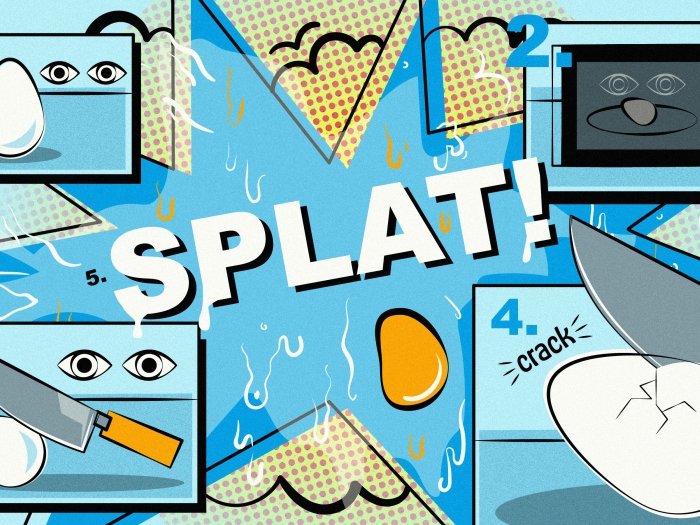Why putting lip balm on eyelids is bad for your eyes
11:00 AM

Originally published March 1, 2023; updated October 31, 2024 to reflect the publication of research findings. Original author: Tessa Roy
Using Burt’s Bees to get buzzed? Bad idea.
“Beezin’,” which gained popularity throughout the 2010s, made a 2023 comeback on TikTok.
Various “beezers” claim that applying Burt’s Bees lip balm to their eyelids gets them high, heightens the sensation of being drunk or high, or increases feelings of alertness. Regardless of the reason, it’s not something anyone should try, says Olivia J. Killeen, M.D., M.S., a pediatric ophthalmologist and former clinical lecturer in the Department of Ophthalmology and Visual Sciences at Michigan Medicine.
In fact, Killeen and colleagues recently published a paper analyzing TikTok content about the beezin’ trend, after first warning about its effects in 2023.
Working with members of the MyVoice adolescent health research team led by senior author Tammy Chang, M.D., M.P.H., M.S., they looked at 60 of the top videos on TikTok about beezin’. They found that together, they’d been viewed more than 158 million times and liked more than 11 million times. Only 11 of the videos portrayed beezin’ negatively, while 37 had a positive tone and 12 were neutral.
Most troubling to Killeen? None of the videos were created by a health care provider, showing a need for more efforts to get accurate health information across on the platform. Killeen, who led the study during her time as a National Clinician Scholar at U-M's Institute for Healthcare Policy and Innovation, is now at Park Nicollet Health in Minnesota.
More about beezin'
To start, beezin’ isn’t actually effective, Killeen says. It’s likely that doing it will create the same feeling on the eyelids as it does on the lips.
“The peppermint oil or menthol in the balm can cause a tingling sensation, but it is not actually getting people high or causing the same type of chemical reaction in the body that’s produced by drugs or alcohol,” Killeen said.
Killeen says beezin’ can cause chemical irritation to the eyelids themselves, resulting in redness, swelling, and inflammation. She also notes that it’s easy for products to accidentally get into the eyes themselves. So, beezin’ can end up causing tearing, redness, and painful burns to the surface of the eyes. In severe instances, it could lead to scarring or vision loss.
As is the case with any time viruses or bacteria are introduced to the surface of the eye, beezin’ may also increase the risk of infection, especially if the lip balm is applied to the eyelids after it was already used on the lips.
Killeen says in some cases, viruses or bacteria from the lips could cause conjunctivitis, commonly known as pink eye. On a more serious level, it may cause infections and ulcers of the eye that can be difficult to treat and lead to permanent vision loss.
Any trend like this is generally a bad idea. Products that are not designed for your eyes should not be used in or around your eyes.
Anyone who tries beezin’ and notices any of the symptoms above should see an eye doctor immediately. Killeen says these issues can occasionally be resolved just by stopping the practice, but some may require additional treatment. That could involve artificial tears or other medications including steroids, antibiotics or antihistamines.
Young people or parents who have questions about the safety of trends like beezin’ can reach out to their primary care doctor or an eye doctor for confidential advice. They can also anonymously speak to an ophthalmologist through the American Academy of Ophthalmology. However, Killeen advises it’s best to just not partake in beezin’ or anything similar.
“Eyes and vision are precious, and both the eyeballs and the eyelids are very sensitive,” Killeen said. “Any trend like this is generally a bad idea. Products that are not designed for your eyes should not be used in or around your eyes.”
Citation: “Beezin”: Analysis of TikTok Content Related to a Viral Social Media Trend
Additional authors: Zara Saleem, MD, Theodora Vorias, MS, Amani Mubeen, Aleah Miller, Rhea Sridhara, Megan Gibson, Anna Wang
Journal of Pediatric Ophthalmology & Strabismus, 2024;0(0):1–3
DOI:10.3928/01913913-20240823-01

Explore a variety of health care news & stories by visiting the Health Lab home page for more articles.

Department of Communication at Michigan Medicine

Associate Professor

Want top health & research news weekly? Sign up for Health Lab’s newsletters today!





